The real estate market is experiencing a significant change as co-living spaces evolve from basic shared accommodations into luxurious communities with various amenities. This innovative housing concept combines private living quarters with shared common areas, creating a unique blend of exclusivity and community living.
The Emergence of High-End Co-Living Spaces
High-end co-living spaces have become a major player in premium real estate markets, providing residents with access to upscale amenities such as:
- Rooftop lounges and entertainment areas
- State-of-the-art fitness centers
- Designer kitchens and dining spaces
- Professional co-working facilities
- Concierge services
The Impact on the Real Estate Industry
This trend is having a broader impact beyond just living arrangements. Here’s how:
- Investors: They are finding significant returns through higher rental income.
- Residents: They can now enjoy luxury living at more affordable prices.
- Real estate developers: They are rethinking property designs to meet the increasing demand for high-end shared living spaces.
Understanding the Factors Behind This Shift
To understand how this trend is changing the real estate landscape, we will explore:
- Who the target demographic is
- How investment performance is measured
- What key factors are driving the market
- What operational challenges exist
- What global market projections look like
- How it affects luxury real estate
This shift in high-end real estate represents a significant departure from traditional housing models, creating new opportunities in urban markets worldwide. The fusion of luxury amenities with community-focused living is setting new standards for modern urban housing solutions.
Understanding Co-Living Spaces
Co-living spaces are a new and innovative alternative to traditional rental arrangements. They offer private bedrooms along with shared living areas, kitchens, and recreational spaces. This unique combination of privacy and community living is transforming urban housing in modern cities.
Key Features of Co-Living Spaces:
- Fully furnished units with utilities included
- Flexible lease terms (1-12 months)
- Built-in cleaning and maintenance services
- High-speed internet and smart home technology
- Professional property management
- Curated community events
The shared amenities in high-end co-living developments elevate the living experience beyond standard apartment offerings. Residents gain access to:
- Rooftop lounges and gardens
- State-of-the-art fitness centers
- Co-working spaces
- Chef’s kitchens
- Entertainment rooms
- Wellness areas
This communal living model creates natural opportunities for social interaction. You might join a yoga class in the morning, work from the shared workspace during the day, and participate in community dinners in the evening. These organic interactions foster meaningful connections among residents who share similar lifestyles and values.
What’s Included in the Pricing?
The pricing structure of co-living spaces offers significant advantages. Your single monthly payment typically covers:
- Rent
- Utilities
- Internet
- Cleaning services
- Building maintenance
- Community events
- Access to all amenities
This all-inclusive approach simplifies budgeting and often results in cost savings compared to traditional rentals in prime locations. The flexibility in lease terms allows you to adapt your living situation to changing circumstances without the long-term commitments typical of conventional rental agreements.
Affordability in High-Cost Urban Areas
The affordability factor becomes particularly apparent in high-cost urban areas, where housing costs can be a significant burden for many individuals. By sharing resources and spaces, residents can access premium locations and amenities that might otherwise be out of reach. This economic efficiency doesn’t compromise quality – instead, it enables access to higher-end facilities through the power of shared resources.
Targeting Professionals and Students: The Appeal of High-End Co-Living
High-end co-living spaces attract a distinct demographic of ambitious young professionals and students seeking premium living experiences. These residents, typically aged 22-35, value both career growth and lifestyle enhancement.
Key Demographics:
- Young professionals in tech, finance, and creative industries
- Graduate students and academics
- Digital nomads with remote work flexibility
- Early-stage entrepreneurs
- International professionals on temporary assignments
The appeal lies in the carefully curated blend of luxury and practicality. You’ll find these spaces equipped with features that cater specifically to work-life integration:
Premium Amenities:
- Private meeting rooms and co-working spaces
- High-speed fiber internet throughout
- Sound-proofed phone booths
- 24/7 security systems
- Concierge services
Lifestyle Features:
- Designer furniture and modern interiors
- Rooftop lounges with city views
- State-of-the-art fitness centers
- Meditation and yoga spaces
- Gourmet communal kitchens
Location plays a crucial role in attracting this demographic. High-end co-living developments strategically position themselves in:
- Prime urban districts
- Near business hubs
- Close to universities
- Areas with vibrant nightlife
- Neighborhoods with excellent transport links
These spaces create environments where residents can network with like-minded individuals. Regular social events, professional workshops, and networking sessions foster valuable connections. The combination of luxury amenities, prime locations, and built-in professional networks makes high-end co-living particularly attractive to career-focused individuals seeking more than just a place to live.
Additionally, the rise of the digital nomad lifestyle has seen an increase in demand for such living arrangements. With the flexibility to work remotely from anywhere in the world, many digital nomads are now seeking high-end co-living spaces that offer not just comfort but also a conducive environment for work and networking.
Financial Viability: Co-Living Properties as Lucrative Investments
The numbers speak volumes about co-living’s investment potential. Traditional rental properties typically generate 3-5% yields, while co-living spaces deliver impressive returns of 6-15%. This substantial difference stems from optimized space utilization and enhanced income streams.
Key Investment Advantages:
- 40-50% higher rental income compared to traditional properties
- 90-100% occupancy rates through flexible leasing
- Multiple revenue streams from amenities and services
- Reduced tenant turnover costs through community engagement
The financial success of co-living investments relies on strategic space optimization. A 3,000-square-foot traditional apartment might house 3-4 tenants, while the same space in a co-living setup accommodates 8-10 residents through efficient design and shared amenities.
Occupancy Rate Drivers:
- Short-term lease flexibility attracts mobile professionals
- Built-in social networks reduce tenant isolation
- Diverse tenant mix spreads vacancy risk
- Quick adaptation to market demands through modular designs
Property investors benefit from reduced marketing costs as co-living communities often generate organic tenant referrals. The community aspect creates a self-sustaining ecosystem where satisfied residents become brand ambassadors.
Your investment security increases through multi-tenant risk distribution. Rather than relying on a single tenant’s rent, co-living spaces spread risk across numerous residents. This model proves particularly resilient during economic fluctuations, maintaining stable cash flows through varied tenant profiles and flexible lease structures.
The scalability of co-living investments allows property owners to expand operations efficiently. Successful properties can replicate their model across multiple locations, creating economies of scale in management, marketing, and maintenance costs.
Driving Forces Behind Co-Living’s Popularity Surge
The skyrocketing urban housing costs have created a significant shift in housing preferences. In major cities like New York, San Francisco, and London, average rental prices have increased by 50% in the past decade. Co-living spaces address this challenge by offering premium living experiences at a fraction of traditional housing costs.
Key Economic Factors:
- Reduced individual rental burden through shared expenses
- Access to prime locations without premium price tags
- Inclusive utilities and amenities reducing monthly costs
- No need for furniture investments or long-term commitments
The evolution of modern lifestyles has reshaped housing demands. Young professionals now prioritize experiences, flexibility, and community connections over traditional property ownership.
Lifestyle Shifts Driving Co-Living Demand:
- Remote work culture requiring adaptable living spaces
- Rising interest in shared experiences and community building
- Desire for turnkey living solutions
- Growing emphasis on work-life balance
- Increased value placed on social connections
These spaces cater to the mobile professional class seeking both luxury and community. A typical high-end co-living resident can access premium amenities like:
- Dedicated workspace areas
- High-speed internet infrastructure
- Regular community events
- Wellness facilities
- Concierge services
The combination of economic pressures and evolving social preferences has positioned co-living as an attractive solution for urban dwellers seeking both affordability and luxury in their living arrangements.
Overcoming Challenges in Co-Living Operations
Co-living operators face distinct challenges in managing high-end shared living spaces. Privacy concerns rank among the top issues, as residents seek a balance between social interaction and personal space. Operators implement sophisticated security systems, including:
- Keycard access to private rooms
- Smart locks on shared facilities
- 24/7 surveillance in common areas
- Sound-proofed walls between units
Regulatory ambiguities create another layer of complexity. Many cities lack specific zoning laws for co-living spaces, forcing operators to navigate through:
- Building codes designed for traditional housing
- Occupancy restrictions that don’t account for shared living models
- Licensing requirements varying by jurisdiction
- Insurance considerations unique to communal spaces
Successful operators address these challenges through detailed resident agreements, clear community guidelines, and regular feedback sessions. They employ dedicated community managers who maintain the delicate balance between enforcing rules and fostering a welcoming environment. Property management software specifically designed for co-living spaces helps streamline operations and monitor compliance with local regulations.
Future Outlook: Market Projections for Co-Living Spaces
The global co-living sector shows remarkable growth potential, with market projections reaching $15.75 billion by 2025 at a CAGR of 12.3%. Key growth regions include:
- Asia Pacific: Leading the expansion with 40% market share
- North America: Expected 15% year-over-year growth
- Europe: Projected 18% annual increase in co-living developments
Supply-Demand Dynamics in Major Cities
High-end real estate markets in major cities display significant supply-demand gaps. Current data indicates:
- New York: 3:1 demand-to-supply ratio
- London: 2.5:1 applicant-to-room ratio
- Singapore: 85% pre-lease rates for new developments
These trends highlight the concerning housing costs faced by many individuals, which could make co-living an attractive alternative.
Investment Trends Shaping the Sector
Investment trends point to substantial institutional capital flowing into the sector:
- Private equity firms allocating $2.5 billion for co-living developments
- REITs incorporating co-living spaces in mixed-use properties
- Tech companies partnering with developers for smart co-living spaces
Emerging Trends Beyond Metropolitan Areas
The market transformation extends beyond metropolitan areas. Emerging trends include:
- Suburban co-living communities near tech hubs
- University-adjacent luxury co-living developments
- Resort-style co-living spaces in secondary cities
These projections signal a shift in traditional real estate paradigms, with co-living becoming an established asset class in high-end property portfolios. The sector’s growth trajectory suggests sustained expansion across global markets, reshaping urban living concepts. Notably, Canada’s real estate market outlook also reflects these trends, further underscoring the widespread appeal and viability of co-living arrangements.
Conclusion
High-end co-living spaces are changing the game in urban housing markets. This new way of living not only meets the demand for housing but also offers top-notch living experiences that align with today’s lifestyle choices.
The success of this model comes from its ability to combine luxury features with designs that prioritize community, creating spaces where residents can truly flourish.
The rise of co-living in upscale areas marks a significant shift in real estate development. Property developers and investors who understand and embrace this change will find themselves leading the way in a rapidly growing market.
As cities become more crowded and housing preferences continue to evolve, co-living presents a sustainable solution that strikes a balance between affordability and luxury. It proves that shared living can be both sophisticated and profitable.








